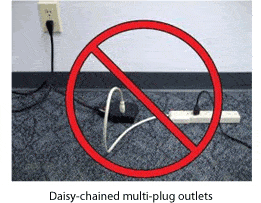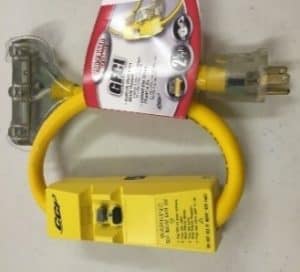 So what’s the problem?
So what’s the problem?
The problem is citations, specifically construction ones. In recent months, electrical citations are increasing. And you could be next.
Daisies are for lazies: Turns out, Compliance Officers aren’t in the spring mood like the rest of us and are cracking down on ‘Daisy Chains.’ No, not the kind my little sis Suzie makes for our cat. The kind where multiple extension cords are plugged into each other. The Officers are citing 29 CFR 1926.403(b)(2), since manufacturer labels are pretty clear this is a big no-no. So don’t do it.
Into the wall or not at all: That’s also causing these Officers to pay special attention to Ground Fault Current Interrupters…whew, that’s a mouth-full. No wonder people call them GFCIs. Anyways, extension cords (the non-daisy-chained ones) can only be plugged into GFCIs. Not normal outlets, not a splitter, and definitely not Uncle Fester. The rule of thumb is that an extension cord has to go directly from the power source to the equipment or machinery. Easy enough.
Solutions to this problem
Lucky for us, the kind folks at Safex have some solutions to this mess.
- Work less than 100 feet away from source of power so only one 100 foot extension cord is needed. Even Suzie can’t daisy-chain one daisy.
- Perform work with battery operated tools/equipment. Just skip the cords altogether. We’re in a wireless world, after all.
- Add more electrical junction boxes. More boxes, more convenience. And no hassle.
- Have more portable generators at the work site. If you can’t move the work, move the power. That’s called problem-solving, my friends.
- Preplan where the most work is going to be before the work starts. A plan in time saves lots of dimes. I think I heard that somewhere. It’s a thing.

- If you’re working at heights and near windows, run your power from inside the building and through the window. Someone put the windows there. Might as well use them.
- Use a Coleman Cable Systems Pro Power 12 Gauge GFCI, as long as UL listed or CSA certified outdoor extension cord is in the GFCI output only. I have no idea what this means, but that’s why we have the people at Safex. They’re all smart like that.
One last thing to remember. This isn’t some new-fangled standard. This already exists, so compliance is expected now. Get out there are rock the electrical safety.

 So what’s the problem?
So what’s the problem?